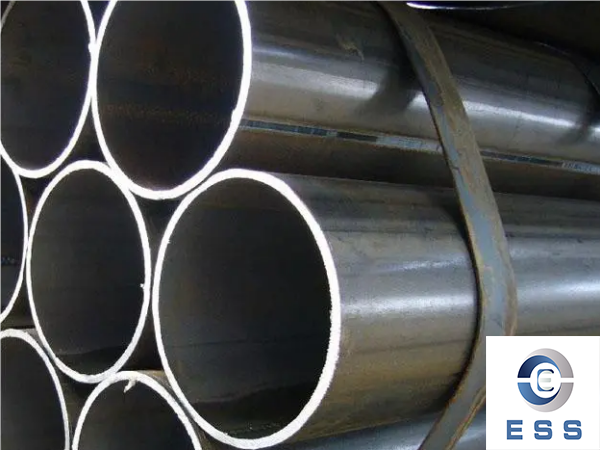Why does pitting corrosion occur in the welds of welded pipes?
The weld surface indentation of submerged arc welded steel pipes (straight seam submerged arc welded pipes or spiral submerged arc welded pipes) refers to the weld seam defect where the weld surface is partially lower than the normal surface of the weld. It is a common weld surface defect in submerged arc welding. In the production of submerged arc welded steel pipes, the weld seams are usually relatively long. Especially in the production of one-step spiral submerged arc welded steel pipes, thousands of meters of submerged arc welds are often welded at one time, so it is easier to produce pits on the surface of the weld.

Dangers of weld surface indentation
1. When the depth of indentation on the surface of the weld is >1.5mm, it must be treated as a weld defect. Once a steel pipe has several welding pits that are lower than the base metal, it will easily cause the steel pipe to deteriorate or even be scrapped, which will at least increase the repair cost of steel pipe production.
2. Due to the widespread application of 3PE external anti-corrosion technology for dry steel pipes and the impact of weld height on the thinning of the anti-corrosion layer, submerged arc welded steel pipes currently require the welding front height to be as low as possible to save anti-corrosion costs as much as possible. In actual production, some steel pipe manufacturers control the reinforcement of the outer weld to ≤1mm on the premise that it is not lower than the surface of the base metal of the steel pipe. At this time, if the indentation depth on the weld surface is >1mm, the weld will be lower than the base metal, causing serious weld defects.
3. For submerged arc welded steel pipes with inner powder coating and outer 3PE anti-corrosion, anti-corrosion defects such as leakage or 3PE anti-corrosion bubbles are prone to occur at the pits on the weld surface, which affects the welding performance. Anti-corrosion quality of steel pipes.
Factors affecting the formation of pressure pits
It can be seen from the formation process of indentations that the more gas generated in the welding pool, the easier it is to produce weld indentations. The greater the resistance of the flux layer and slag to gas escape, the more difficult it is for gas to escape, and the easier it is to produce pressure pits.
Measures to prevent weld pitting corrosion
1. Choose the appropriate flux:
On the premise of ensuring the internal quality of the weld, flux with low oxidation, low viscosity, low surface tension, and low bulk density should be selected. In addition, in order to improve the permeability of the flux, a flux with smaller particle pads should be selected, especially when welding with high current. The flux particles should be as uniform as possible, and the particle size is generally controlled within 10-60 mesh. It is not allowed to mix coarse-grained flux with excessively fine flux. For the flux used in submerged arc welding of steel pipes, it is necessary to ensure that the flux recovery system can suck away the fine flux to ensure that the particle size of the flux is relatively uniform.
2. Correct use of flux:
The flux should be kept clean during use and should be free of rust, dust, iron oxide and other impurities. The iron oxide in the flux must be removed by magnetic separation in order to recover or recover the flux. The flux should be dried at the specified temperature before use to ensure the moisture content in the flux. Under normal circumstances, the moisture content in the flux should be ≤0.1%
3 Reasonable selection of tube blanks and welding wires:
In terms of material selection, try to choose tube blanks and welding wires with lower content of C, O, N, H and other elements to reduce the generation of gases during welding.
4. Reasonably select welding parameters:
On the premise of ensuring the quality of the weld, using a smaller welding current can reduce the generation of gas and reduce welding pits. Appropriately increasing the arc voltage can enlarge the arc cavity, thin the welding slag layer, reduce the resistance and bubble pressure of gas escape in the arc cavity, and help reduce weld pitting corrosion. Reducing the welding speed can increase the existence time of the liquid molten pool and low-viscosity slag, which is beneficial to gas escape and reduces pitting corrosion.
5. Maintain a reasonable welding inclination angle:
Increasing the downhill welding angle will thin the slag layer due to the flow of slag, which is beneficial to reducing pitting corrosion. In submerged arc welding steel pipe welding, the eccentricity and inclination angle of the welding wire can be reasonably adjusted to ensure welding at the best angle and reduce and prevent weld pitting corrosion.













 Eastern Steel Manufacturing Co.,Ltd not only improve product production and sales services, but also provide additional value-added services. As long as you need, we can complete your specific needs together.
Eastern Steel Manufacturing Co.,Ltd not only improve product production and sales services, but also provide additional value-added services. As long as you need, we can complete your specific needs together.










